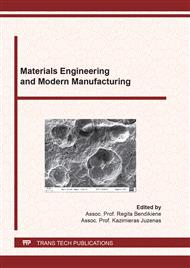p.83
p.90
p.97
p.103
p.113
p.119
p.126
p.131
p.139
Chemical Bonded Oil-PTFE-PA66 Composites as Novel Tribologically Effective Materials: Part 1
Abstract:
Polytetrafluoroethylene (PTFE) is characterized by outstanding non-stick properties and very low friction coefficients under tribological load. However, PTFE is incompatible with almost all other polymers exhibits cold flow and a low wear resistivity. However, PTFE can be modified e.g. in the presence of air by using high-energy radiation to achieve carboxylic acid fluorid- (-COF), carboxyl- (-COOH) functional groups and persistent perfluoroalkyl (peroxy) radicals. The hydrophilic functional groups of radiation-modified PTFE can be used to generate a chemically covalent coupling with other monomers/polymers (e.g. polyamides) via addition reactions. Another approach to get a chemical bonding of modified PTFE is the use of radicals for the covalent attachment of olefinic groups (e.g. in oils) through radical reactions. It is already known that the dispersion of modified PTFE in synthetic oils at elevated temperatures results in very stable PTFE-oil dispersions, which have improved tribological properties and are compatible with metals.The aim of this study is the development of novel tribologically effective materials based on radiation-modified PTFE, oil and polyamide 66 (PA66). In the first synthesis step, a chemical coupling between selected oils and various types of PTFE was performed. The bonding was proved by fourier-transform infrared spectroscopy (FTIR) after removing oil excess and further extraction of insoluble residue. Additional electron spin resonance measurements (ESR) showed that the linkages mainly resulted from radical reactions. The second processing step was the chemical coupling of PA66 and oil-modified PTFE by reactive extrusion. In order to get an idea about the influence of the chemical bonding of both lubricants with the polymer matrix on the mechanical material properties compared to origin PA66, multipurpose test specimens according to ISO 3167 were prepared by injection molding. It was found, that even bigger amounts of bonded lubricants did not deteriorate the mechanical characteristics in a significant manner. Finally, initial tribological testing of the novel materials was carried out by using a block on ring tribometer test set up. The antifriction and wear behaviour, as well as the transfer film thickness, were analyzed subsequently.
Info:
Periodical:
Pages:
113-118
Citation:
Online since:
June 2021
Price:
Сopyright:
© 2021 Trans Tech Publications Ltd. All Rights Reserved
Share:
Citation:


